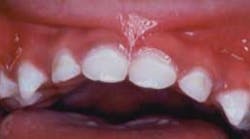Student poster sessions, table clinics from ADHA annual session featured
Infant Oral Health Education in Michigan Dental Hygiene Programs
Sarah Barbuscak, Rebecca Cathey, Katherine Hanner, and Lindsey Respondek, students from the University of Detroit Mercy, School of Dentistry
As part of the dental team, hygienists have a significant role in promoting oral health in the prevention of oral diseases in infants and children. The purpose of this study was to evaluate didactic and clinical curricula of dental hygiene programs in Michigan regarding infant oral health (IOH). A questionnaire was sent to all dental hygiene program directors in Michigan. Questions were related to inclusion of IOH in the curriculum, methods and materials used for teaching, IOH topics being taught, clinical experiences, didactic hours, and obstacles that each program may experience with teaching IOH. Findings showed that all programs teach IOH; 100% of the programs utilized lectures, 70% used videos, online presentations, community rotation and handouts. An average of four didactic hours was devoted to IOH. Only 30% of the directors reported that their hygiene students have experience in clinic patient care. In addition, 44% of the directors considered their students competent upon graduation in providing infant oral health education. Editorial note - For further reading, visit the American Academy of Pediatric Dentistry (AAPD) “Guidelines on Infant Oral Health Care” at www.aapd.org/media/policies_guidelines/g_infantoralhealthcare.pdf. Improving Perinatal and Infant Oral Health (AAPD) at www.cdhp.org/programs/improving_perinatal_and_infant_oral_health_aapd/improving_perinatal_and_infant_oral_health_. First 5 California at www.first5california.com/. Bright Futures Toolbox: Health Professionals and Human Services Providers at www.mchoralhealth.org/Toolbox/professionals.html. Stepping Up to the Plate
Jennifer Takata and Melinda Lau, students from the University of Hawaii at Manoa
Toni-Ann Restivo, AS, BS, student at New York City College of Technology’s (City Tech).This poster and brochure highlighted the growing fad of smoking tobacco through a hookah, or water pipe. It has become a very popular social activity for young Americans, including college students. Hookah cafés and bars have proliferated in the past decade in the USA, and have always been popular in other parts of the world. “Hookah smoking originated in India roughly 400 years ago, as did the smoking of “bidi” cigarettes, made by rolling tobacco in the leaves of the tendu tree and sometimes flavoring them for sweetness. As anti-smoking legislation continues to build, bidi cigarettes have become scarce in the New York metropolitan area, while hookah smoking opportunities, even for those of high school age, have become easier to find at lounges, bars, or restaurants offering DJs, dancing, table service, and occasionally an outdoor patio. In 2003, New York Magazine even named the top five hookah bars.” (Brooklyn, N.Y. -- July 6, 2011 -- New York City College of Technology Press Release).
Dental Stem Cells: You Can Bank on Them, Harrisburg Area Community College, Rebecca Boyles and Maureen Trnka Table Clinic 2nd Place
Xylitol Syrup Never Tasted So Sweet, University of Southern California, Robin Nanda, David Tran, and Cristy Bentley Table Clinic 3rd Place
Alternative Smoking Using Hookah or Bidi Cigarettes: Implications on Oral Health, New York City College of Technology, Toni-Ann Restivo Table Clinic Honorable Mention
Connecting the Dots: TMD & Body Posture, Cerritos College, Katherine Carter and Jennifer Edington
Maria Perno Goldie, RDH, MS
To read previous articles in RDH eVillage FOCUS from 2011 written by Maria Perno Goldie, go to articles.











